Blog & Latest Updates
Fly Fishing Articles
Insects by Common Name


Latest updates, page 47
Updates from November 9, 2011
Closeup insects by Entoman from the Fall River in California
Female Anafroptilum album (Tiny Sulphur Dun) Mayfly Dun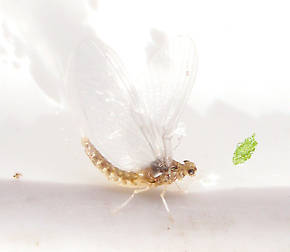 View 3 PicturesApprox. 5 mm. This is a very significant hatch. It is mostly seen at the height of Summer and I was very surprised to see it emerging this late in the season and in such numbers. When this one is emerging, the fish can become quite selective.
View 3 PicturesApprox. 5 mm. This is a very significant hatch. It is mostly seen at the height of Summer and I was very surprised to see it emerging this late in the season and in such numbers. When this one is emerging, the fish can become quite selective.
 View 3 PicturesApprox. 5 mm. This is a very significant hatch. It is mostly seen at the height of Summer and I was very surprised to see it emerging this late in the season and in such numbers. When this one is emerging, the fish can become quite selective.
View 3 PicturesApprox. 5 mm. This is a very significant hatch. It is mostly seen at the height of Summer and I was very surprised to see it emerging this late in the season and in such numbers. When this one is emerging, the fish can become quite selective.Collected November 9, 2011 from the Fall River in California
Added to Troutnut.com by Entoman on December 10, 2011
Added to Troutnut.com by Entoman on December 10, 2011
Some last glimpses of liquid water for the year in interior Alaska
Winter's already in full swing up here, except that the rivers haven't finished freezing up. The ice here will be 4 feet deep by March.
Photos by Troutnut from the Tanana River in Alaska

StateAlaska
LocationTanana River
Date TakenNov 5, 2011
Date AddedNov 10, 2011
AuthorTroutnut
CameraDMC-LX3

StateAlaska
LocationTanana River
Date TakenNov 5, 2011
Date AddedNov 10, 2011
AuthorTroutnut
CameraDMC-LX3

StateAlaska
LocationTanana River
Date TakenNov 5, 2011
Date AddedNov 10, 2011
AuthorTroutnut
CameraDMC-LX3
Updates from October 22, 2011
Closeup insects by Entoman from the Fall River and the Susquehanna River in California and Pennsylvania
Female Paraleptophlebia debilis (Mahogany Dun) Mayfly Dun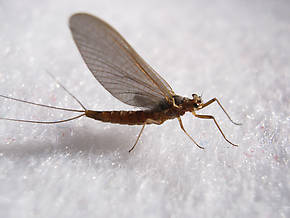 View 3 PicturesSize: 9mm. These photos really highlight the brown pigmentation of the wing venation (Venation: The pattern in which the veins on the wings of an insect are arranged. It is usually one of the most useful identifying characteristics.), but in the hand the wings look to be a uniform smokey gray. - Entoman
View 3 PicturesSize: 9mm. These photos really highlight the brown pigmentation of the wing venation (Venation: The pattern in which the veins on the wings of an insect are arranged. It is usually one of the most useful identifying characteristics.), but in the hand the wings look to be a uniform smokey gray. - Entoman
 View 3 PicturesSize: 9mm. These photos really highlight the brown pigmentation of the wing venation (Venation: The pattern in which the veins on the wings of an insect are arranged. It is usually one of the most useful identifying characteristics.), but in the hand the wings look to be a uniform smokey gray. - Entoman
View 3 PicturesSize: 9mm. These photos really highlight the brown pigmentation of the wing venation (Venation: The pattern in which the veins on the wings of an insect are arranged. It is usually one of the most useful identifying characteristics.), but in the hand the wings look to be a uniform smokey gray. - EntomanCollected October 22, 2011 from the Fall River in California
Added to Troutnut.com by Entoman on February 4, 2012
Added to Troutnut.com by Entoman on February 4, 2012
Male Heptagenia culacantha Mayfly Spinner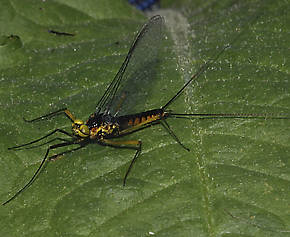 View 1 PicturesThis photo was provided by guide Eric Naguski along with the following comments, "I took this photo just upstream of Three Mile Island on the east shore of the Susquehanna River just below where the Swatara Creek enters. The Susquehanna is not an easy river to sample for bugs in my opinion. It is very large and pushes a lot of water. Especially in the spring when you would collect mature culacantha nymphs. And I don't believe that there are a ton of these Heptageniids around. Also the people who are doing most of the sampling like myself are doing so for water quality monitoring work so they only take the specimens down to genus-level taxonomy".
View 1 PicturesThis photo was provided by guide Eric Naguski along with the following comments, "I took this photo just upstream of Three Mile Island on the east shore of the Susquehanna River just below where the Swatara Creek enters. The Susquehanna is not an easy river to sample for bugs in my opinion. It is very large and pushes a lot of water. Especially in the spring when you would collect mature culacantha nymphs. And I don't believe that there are a ton of these Heptageniids around. Also the people who are doing most of the sampling like myself are doing so for water quality monitoring work so they only take the specimens down to genus-level taxonomy".
 View 1 PicturesThis photo was provided by guide Eric Naguski along with the following comments, "I took this photo just upstream of Three Mile Island on the east shore of the Susquehanna River just below where the Swatara Creek enters. The Susquehanna is not an easy river to sample for bugs in my opinion. It is very large and pushes a lot of water. Especially in the spring when you would collect mature culacantha nymphs. And I don't believe that there are a ton of these Heptageniids around. Also the people who are doing most of the sampling like myself are doing so for water quality monitoring work so they only take the specimens down to genus-level taxonomy".
View 1 PicturesThis photo was provided by guide Eric Naguski along with the following comments, "I took this photo just upstream of Three Mile Island on the east shore of the Susquehanna River just below where the Swatara Creek enters. The Susquehanna is not an easy river to sample for bugs in my opinion. It is very large and pushes a lot of water. Especially in the spring when you would collect mature culacantha nymphs. And I don't believe that there are a ton of these Heptageniids around. Also the people who are doing most of the sampling like myself are doing so for water quality monitoring work so they only take the specimens down to genus-level taxonomy".Collected October 22, 2011 from the Susquehanna River in Pennsylvania
Added to Troutnut.com by Entoman on February 10, 2012
Added to Troutnut.com by Entoman on February 10, 2012
Updates from October 16, 2011
Closeup insects by Entoman from the Fall River in California
Female Ephemerella excrucians (Pale Morning Dun) Mayfly Dun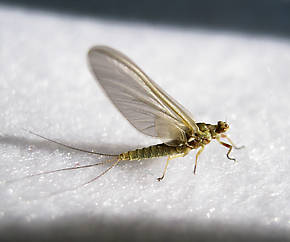 View 3 PicturesSize: 10mm. At emergence the specimen was a fairly bright olive green and there was obvious difference in color between the forewing (med. dun) and the hind-wing (pale cream). It was really noticeable as they floated by. You can just make these features out in the second photo, but not so much in the first that was taken 24 hours after capture. Total time from emergence to molting - approx. 48 hours.
View 3 PicturesSize: 10mm. At emergence the specimen was a fairly bright olive green and there was obvious difference in color between the forewing (med. dun) and the hind-wing (pale cream). It was really noticeable as they floated by. You can just make these features out in the second photo, but not so much in the first that was taken 24 hours after capture. Total time from emergence to molting - approx. 48 hours.
Entoman
Edit 2/25/13 - This specimen was originally posted to E. d. infrequens because of its size. It turns out large size doesn't hold up as a way to tell these two apart. This is because excrucians has much greater variability than previously understood. The assumption by anglers that excrucians is always the smaller of the two is apparently not supported by science. There is a lot left to sort out with western Ephemerella species. This may include new discoveries and/or synonyms (Synonym: A former name of a taxon, usually a species. Entomologists frequently discover that two insects originally described as different species are one in the same, and they drop one of the names. The dropped name is said to be a synonym of the remaining name. These changes take a while to trickle into the common knowledge of anglers; for example, Baetis vagans is now a synonym of Baetis tricaudatus.) as well as reportage on new intraspecific variations broadening the descriptions of recognized species. Based on this specimen's Fall maturity, the best guess is that it is an unusual form of excrucians.
As to color, both species duns (nymphs too) demonstrate a tremendous amount of intraspecific variability from pale yellow to bright green with a multitude of sulfur shadings in between, ranging from pale amber, through orange to cinnamon and even dark brown. I've seen wings from pale cream through tannish and almost every shade of dun except the dark shades. Some have pigment stained leading edges matching their bodies, some don't. Most of these variations are undocumented except in angler references and periodicals. It seems a rare year that a new variation doesn't pop up to the notice of anglers.
Bottom line - size is only reliable if the specimens are smaller than size 16, pointing to excrucians. Otherwise, the only fairly dependable way to tell them apart (especially the females) is by timing as infrequens is the first of the two to appear, rarely lasting longer than a couple of weeks or later than the end of June most years. The problem with using timing for determination is it requires knowledge of the hatch sequences as they actually occurred for a given year on a given piece of water. Obviously, this kind of information is seldom available. Without it, determining between the two duns if they are larger than size 18 is speculative at best - at least until very late in the Summer.
 View 3 PicturesSize: 10mm. At emergence the specimen was a fairly bright olive green and there was obvious difference in color between the forewing (med. dun) and the hind-wing (pale cream). It was really noticeable as they floated by. You can just make these features out in the second photo, but not so much in the first that was taken 24 hours after capture. Total time from emergence to molting - approx. 48 hours.
View 3 PicturesSize: 10mm. At emergence the specimen was a fairly bright olive green and there was obvious difference in color between the forewing (med. dun) and the hind-wing (pale cream). It was really noticeable as they floated by. You can just make these features out in the second photo, but not so much in the first that was taken 24 hours after capture. Total time from emergence to molting - approx. 48 hours.Entoman
Edit 2/25/13 - This specimen was originally posted to E. d. infrequens because of its size. It turns out large size doesn't hold up as a way to tell these two apart. This is because excrucians has much greater variability than previously understood. The assumption by anglers that excrucians is always the smaller of the two is apparently not supported by science. There is a lot left to sort out with western Ephemerella species. This may include new discoveries and/or synonyms (Synonym: A former name of a taxon, usually a species. Entomologists frequently discover that two insects originally described as different species are one in the same, and they drop one of the names. The dropped name is said to be a synonym of the remaining name. These changes take a while to trickle into the common knowledge of anglers; for example, Baetis vagans is now a synonym of Baetis tricaudatus.) as well as reportage on new intraspecific variations broadening the descriptions of recognized species. Based on this specimen's Fall maturity, the best guess is that it is an unusual form of excrucians.
As to color, both species duns (nymphs too) demonstrate a tremendous amount of intraspecific variability from pale yellow to bright green with a multitude of sulfur shadings in between, ranging from pale amber, through orange to cinnamon and even dark brown. I've seen wings from pale cream through tannish and almost every shade of dun except the dark shades. Some have pigment stained leading edges matching their bodies, some don't. Most of these variations are undocumented except in angler references and periodicals. It seems a rare year that a new variation doesn't pop up to the notice of anglers.
Bottom line - size is only reliable if the specimens are smaller than size 16, pointing to excrucians. Otherwise, the only fairly dependable way to tell them apart (especially the females) is by timing as infrequens is the first of the two to appear, rarely lasting longer than a couple of weeks or later than the end of June most years. The problem with using timing for determination is it requires knowledge of the hatch sequences as they actually occurred for a given year on a given piece of water. Obviously, this kind of information is seldom available. Without it, determining between the two duns if they are larger than size 18 is speculative at best - at least until very late in the Summer.
Collected October 16, 2011 from the Fall River in California
Added to Troutnut.com by Entoman on October 21, 2011
Added to Troutnut.com by Entoman on October 21, 2011
Updates from October 15, 2011
Closeup insects by Entoman from the Fall River in California
Female Brachycentrus americanus (American Grannom) Caddisfly Adult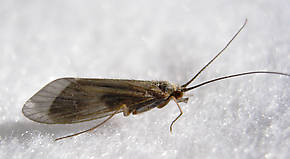 View 1 PicturesSize 11 mm. Prior to this photo the specimen dropped its large egg mass that was a very dark (almost black) olive sphere almost twice the diameter of the abdomen. Notice the abdomen visible through the wings is both thickened and shortened post egg drop.
View 1 PicturesSize 11 mm. Prior to this photo the specimen dropped its large egg mass that was a very dark (almost black) olive sphere almost twice the diameter of the abdomen. Notice the abdomen visible through the wings is both thickened and shortened post egg drop.
 View 1 PicturesSize 11 mm. Prior to this photo the specimen dropped its large egg mass that was a very dark (almost black) olive sphere almost twice the diameter of the abdomen. Notice the abdomen visible through the wings is both thickened and shortened post egg drop.
View 1 PicturesSize 11 mm. Prior to this photo the specimen dropped its large egg mass that was a very dark (almost black) olive sphere almost twice the diameter of the abdomen. Notice the abdomen visible through the wings is both thickened and shortened post egg drop.Collected October 15, 2011 from the Fall River in California
Added to Troutnut.com by Entoman on October 21, 2011
Added to Troutnut.com by Entoman on October 21, 2011
Top 10 Fly Hatches
Top Gift Shop Designs
Eat mayflies.
Top Insect Specimens
Miscellaneous Sites
Troutnut.com is copyright © 2004-2024 Jason
Neuswanger (email Jason). See my FAQ for information about use of my images.
 privacy policy
privacy policy
